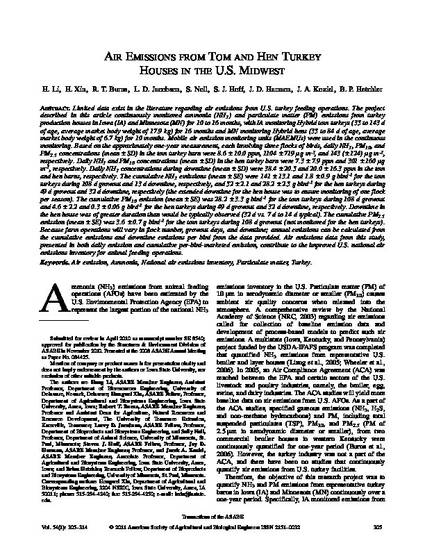
Limited data exist in the literature regarding air emissions from U.S. turkey feeding operations. The project described in this article continuously monitored ammonia (NH3) and particulate matter (PM) emissions from turkey production houses in Iowa (IA) and Minnesota (MN) for 10 to 16 months, with IA monitoring Hybrid tom turkeys (35 to 143 d of age, average market body weight of 17.9 kg) for 16 months and MN monitoring Hybrid hens (35 to 84 d of age, average market body weight of 6.7 kg) for 10 months. Mobile air emission monitoring units (MAEMUs) were used in the continuous monitoring. Based on the approximately one-year measurement, each involving three flocks of birds, daily NH3, PM10, and PM2.5 concentrations (mean ±SD) in the tom turkey barn were 8.6 ±10.0 ppm, 1104 ±719 µg m-3, and 143 (±124) µg m-3, respectively. Daily NH3 and PM10 concentrations (mean ±SD) in the hen turkey barn were 7.3 ±7.9 ppm and 301 ±160 µg m-3, respectively. Daily NH3 concentrations during downtime (mean ±SD) were 38.4 ±20.5 and 20.0 ±16.3 ppm in the tom and hen barns, respectively. The cumulative NH3 emissions (mean ±SE) were 141 ±13.1 and 1.8 ±0.9 g bird-1 for the tom turkeys during 108 d growout and 13 d downtime, respectively, and 52 ±2.1 and 28.2 ±2.5 g bird-1 for the hen turkeys during 49 d growout and 32 d downtime, respectively (the extended downtime for the hen house was to ensure monitoring of one flock per season). The cumulative PM10 emission (mean ±SE) was 28.2 ±3.3 g bird-1 for the tom turkeys during 108 d growout and 4.6 ±2.2 and 0.3 ±0.06 g bird-1 for the hen turkeys during 49 d growout and 32 d downtime, respectively. Downtime in the hen house was of greater duration than would be typically observed (32 d vs. 7 d to 14 d typical). The cumulative PM2.5 emission (mean ±SE) was 3.6 ±0.7 g bird-1 for the tom turkeys during 108 d growout (not monitored for the hen turkeys). Because farm operations will vary in flock number, growout days, and downtime; annual emissions can be calculated from the cumulative emissions and downtime emissions per bird from the data provided. Air emissions data from this study, presented in both daily emission and cumulative per-bird-marketed emission, contribute to the improved U.S. national air emissions inventory for animal feeding operations.
Available at: http://works.bepress.com/steven_hoff/24/

This article is from Transactions of the ASABE 54, no. 1 (2011): 305–314.